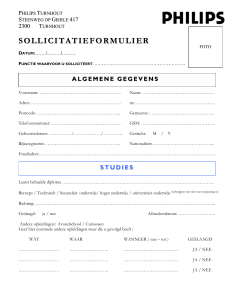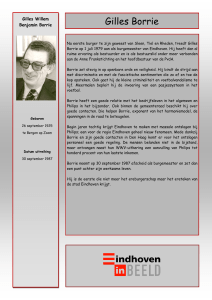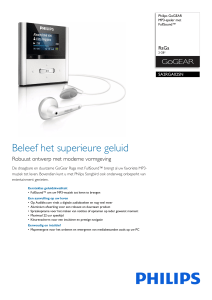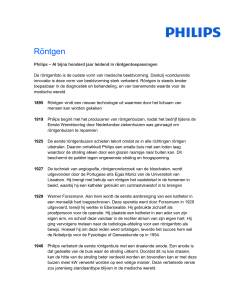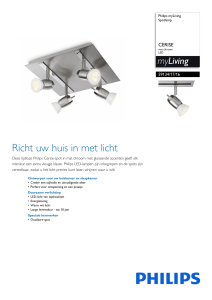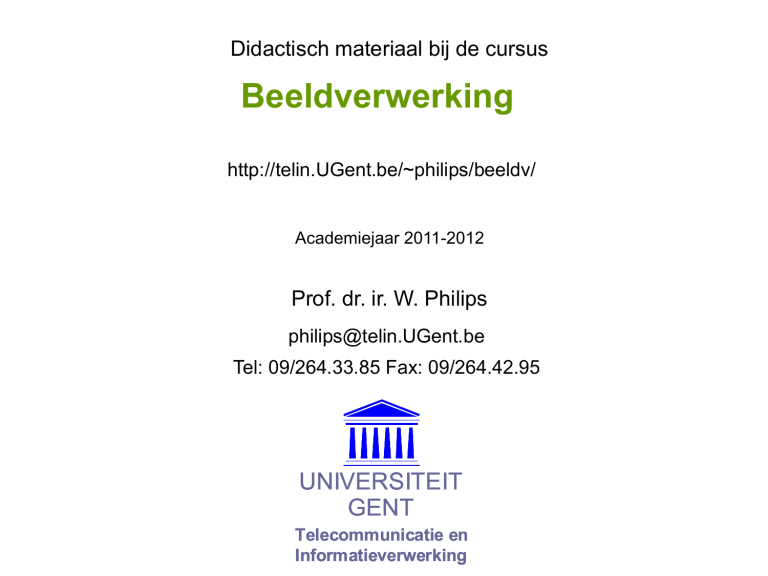
Didactisch materiaal bij de cursus
Beeldverwerking
http://telin.UGent.be/~philips/beeldv/
Academiejaar 2011-2012
Prof. dr. ir. W. Philips
[email protected]
Tel: 09/264.33.85 Fax: 09/264.42.95
UNIVERSITEIT
GENT
Telecommunicatie en
Informatieverwerking
© W. Philips, Universiteit Gent, 1998-2012
versie: 16/11/2011
Copyright notice
This powerpoint presentation was developed as an educational aid to the renewed course “Image processing” (Beeldverwerking), taught at the University of Gent, Belgium as
of 1998.
This presentation may be used, modified and copied free of charge for non-commercial purposes by individuals and non-for-profit organisations and distributed free of charge
by individuals and non-for-profit organisations to individuals and non-for-profit organisations, either in electronic form on a physical storage medium such as a CD-rom,
provided that the following conditions are observed:
1. If you use this presentation as a whole or in part either in original or modified form, you should include the copyright notice “© W. Philips, Universiteit Gent, 19982002” in a font size of at least 10 point on each slide;
2. You should include this slide (with the copyright conditions) once in each document (by which is meant either a computer file or a reproduction derived from such a
file);
3. If you modify the presentation, you should clearly state so in the presentation;
4. You may not charge a fee for presenting or distributing the presentation, except to cover your costs pertaining to distribution. In other words, you or your organisation
should not intend to make or make a profit from the activity for which you use or distribute the presentation;
5. You may not distribute the presentations electronically through a network (e.g., an HTTP or FTP server) without express permission by the author.
In case the presentation is modified these requirements apply to the modified work as a whole. If identifiable sections of that work are not derived from the presentation, and
can be reasonably considered independent and separate works in themselves, then these requirements do not apply to those sections when you distribute them as separate
works. But when you distribute the same sections as part of a whole which is a work based on the presentation, the distribution of the whole must be on the terms of this
License, whose permissions for other licensees extend to the entire whole, and thus to each and every part regardless of who wrote it. In particular note that condition 4 also
applies to the modified work (i.e., you may not charge for it).
“Using and distributing the presentation” means using it for any purpose, including but not limited to viewing it, presenting it to an audience in a lecture, distributing it to
students or employees for self-teaching purposes, ...
Use, modification, copying and distribution for commercial purposes or by commercial organisations is not covered by this licence and is not permitted without the author’s
consent. A fee may be charged for such use.
Disclaimer: Note that no warrantee is offered, neither for the correctness of the contents of this presentation, nor to the safety of its use. Electronic documents such as this
one are inherently unsafe because they may become infected by macro viruses. The programs used to view and modify this software are also inherently unsafe and may
contain bugs that might corrupt the data or the operating system on your computer.
If you use this presentation, I would appreciate being notified of this by email. I would also like to be informed of any errors or omissions that you discover. Finally, if you have
developed similar presentations I would be grateful if you allow me to use these in my course lectures.
Prof. dr. ir. W. Philips
Department of Telecommunications and Information Processing
University of Gent
St.-Pietersnieuwstraat 41, B9000 Gent, Belgium
E-mail: [email protected]
Fax: 32-9-264.42.95
Tel: 32-9-264.33.85
08b.2
© W. Philips, Universiteit Gent, 1998-2012
versie: 16/11/2011
Overzicht
Degradatiemodel
Lineaire restauratie in het Fourierdomein
•Invers filter + toepassing (unsharp masking)
•Toepassing invers filter: Homomorfisch filter (contrastaanpassing)
•Het Wiener filter (theoretisch optimaal filter)
Modelgebaseerde beeldrestauratie: algemene principes
•Bayesiaanse technieken: statistische modellen
•Regularisatie: penalisatie van niet-gewenste lokale beeldstructuren
Cartoon-modellen: “beelden bestaan uit egale gebieden gescheiden
door randen”
•Markov random velden
•Total variation
Lineaire en niet-lineaire diffusie: vooral bedoeld als voorbewerking voor
beeldanalyse
08b.3
Lineaire en niet lineaire diffusie
© W. Philips, Universiteit Gent, 1998-2012
versie: 16/11/2011
Lineaire diffusie
Beeld filteren met gaussiaanse PSF met s2=2t
1
x2 y2
ht ( x, y )
exp
4 t
4t
De beelden bt(x,y)=(b * ht)(x,y) voldoen aan de lineaire diffusievergelijking
2
2
2
2
bt ( x, y ) bt ( x, y ) met
2
2
t
x
y
Eigenschap gaussiaans filter: ht+t’(x,y)=(ht’ * ht)(x,y)
2 maal toepassen van een filter met t=a filter met t=2a
en n maal toepassen van filter met t=a filter met t=na
Toepassing: berekenen van alle bt(x,y) met t=nt0 via een cascade van filters
ha(x,y)
ha(x,y)
n=1
ha(x,y)
n=2
ha(x,y)
…
n=3
De implementatie via een cascade is veel sneller dan rechtstreekse
berekening (veel groter filtermasker nodig voor t=na dan voor t=a
08b.5
© W. Philips, Universiteit Gent, 1998-2012
versie: 16/11/2011
Lineaire diffusie en “scale-space”
De beelden bt(x,y) met t=2na = “scale-space” ontbinding van b(x,y)
Eigenschappen: bij toenemende t
•de beelden hebben allemaal dezelfde gemiddelde waarde
•ze worden steeds waziger en worden steeds meer “details” door de
verwaziging weggeveegd
•de ruis wordt zwakker en zwakker
Toepassing: multischaal-analyse
•detecteer grote objecten in de heel wazige
beelden
•detecteer kleinere objecten in de scherpe
beelden
Toepassing: ruisonderdrukking
•de verschilbeelden bt(x,y)-bt-a(x,y) hebben
gelijkaardige beelden als de waveletdetailbeelden
shrinkage-gebaseerde technieken
origineel
n=30
n=1
n=10
n=20beeld
08b.6
© W. Philips, Universiteit Gent, 1998-2012
versie: 16/11/2011
Isotrope niet-lineaire diffusie
Bedoeling: uitschakeling van het diffusieproces in de omgeving van
beeldranden, d.w.z. berekenen van een cartoon-model
ruisonderdrukking in egale gebieden, maar behoud van randen
Algemeen schema (Perona en Malik)
bt
f x ( x, y ) f x f y
x
b
en .
bt ( x, y ) .c bt ( x, y ) bt ( x, y ) met t
b
f
(
x
,
y
)
x
y
t
t
y
y
Bijzondere gevallen:
2
• c(g)=1 lineaire diffusie want .f ( x, y) f ( x, y)
• Perona Malik: c g e
g2 / K 2
Perona Malik:
c g 1 1 g 2 / K 2
bt ( x, y ) .1bt ( x, y ) 2bt ( x, y )
t
•voor grote gradiënten:
bt ( x, y ) .0bt ( x, y ) 0
t
de diffusie wordt “gestopt” aan beeldranden omdat de gradiënt g daar
groot is
•voor kleine gradiënten:
08b.7
© W. Philips, Universiteit Gent, 1998-2012
versie: 16/11/2011
Anisotrope niet-lineaire diffusie…
Bedoeling: de diffusie aan de beeldranden niet volledig uitschakelen,
maar daar uitmiddelen volgens een richting parallel aan de rand
ruisonderdrukking in egale gebieden, en aan randen
Algemeen schema
bt ( x, y ) .C bt ( x, y ) bt ( x, y ) met C(.) een vierkante matrix
t
Bijzondere gevallen:
e g x2 / K 2
• Perona Malik 1: C g
0
cx
g 2y / K 2 0
e
1 1 g x2 / K 2
• Perona Malik 2: C g
0
0
0
cy
cx
2
2 0
1 1 g y / K
0
0
cy
Opmerking: wij beperken ons tot diagonale C(.), maar dat hoeft niet!
08b.8
© W. Philips, Universiteit Gent, 1998-2012
versie: 16/11/2011
…Anisotrope niet-lineaire diffusie…
Algemeen schema
bt ( x, y ) .C bt ( x, y ) bt ( x, y ) met C(.) een vierkante matrix
t
met b.v. c x e
g x2 / K 2
cy e
g 2y / K 2
Voor voldoend kleine a geldt (zonder bewijs) bt+a(x’,y’)(bt*ht,x’,y’)(x,y)
2
2
1
x
y
ht , x ', y ' ( x, y )
exp
4 c x ( x' , y ' )c y ( x' , y ' ) t
4c x ( x' , y ' )t 4c y ( x' , y ' )t
Interpretatie: spatiaal adaptief (niet-stationair) filter
•lokaal, d.w.z. in de omgeving van een bepaald punt (x’, y’)
•verandert één diffusiestap (overgang t t+a) het beeld als een
gaussiaans filter
•waarbij de vorm van de PSF zich aanpast aan de randsterkte en
randoriëntatie, n.l. aan cx(x’, y’) en cy(x’, y’)
08b.9
© W. Philips, Universiteit Gent, 1998-2012
versie: 16/11/2011
…Anisotrope niet-lineaire diffusie
Voor voldoend kleine a geldt (zonder bewijs) bt+a(x’,y’)(bt*ht,x’,y’)(x,y)
2
2
1
x
y
ht , x ', y ' ( x, y )
exp
4c ( x' , y ' )t 4c ( x' , y ' )t
4 c x ( x' , y ' )c y ( x' , y ' ) t
y
x
met b.v. c x e
g x2 / K 2
cy e
g 2y / K 2
ht,x’,y’=constante
y
Voorbeeld 1: eerder egaal gebied |gx|0 en |gy|0
cx(x’, y’)1 en cy(x’, y’)1
isotrope filtering (in alle richtingen evenveel)
Voorbeeld 2: sterke vertikale rand |gx| zeer groot en |gy|0
cx(x’, y’)0 en cy(x’, y’)1
anisotrope filtering (enkel in de vertikale richting)
x
y
x
08b.10
© W. Philips, Universiteit Gent, 1998-2012
versie: 16/11/2011
Voorbeeld: Perona-Malik 1
Origineel CT beeld
Perona-Malik 1; n=30
n=10
Anisotrope niet-lineaire diffusie behoudt de grote objectstructuren
Ruis en kleine structuren verdwijnen
Veel iteraties nodig voor een “goed” resultaat
08b.11
© W. Philips, Universiteit Gent, 1998-2012
versie: 16/11/2011
Voorbeeld: Perona-Malik 2
Origineel CT beeld
Perona-Malik 2; n=10
In dit geval
•minder iteraties nodig om de ruis evenveel te onderdrukken
•en minder randverwaziging
Er wordt nog veel onderzoek verricht naar de optimale methode
08b.12
© W. Philips, Universiteit Gent, 1998-2012
versie: 16/11/2011
Bibliografie
Voorbeelden van wetenschappelijke artikels (aan te vullen)
Homomorfisch filter
Markov random velden
Total variation ruisonderdrukking
•Guy Gilboa, Nir Sochen, Yehoshua Y. Zeevi, "Texture Preserving Variational
Denoising Using an Adaptive Fidelity Term", Proc. VLSM 2003, Nice, France,
Oct. 2003.
•http://visl.technion.ac.il/~gilboa/PDE-filt/tv_denoising.html
Lineaire, niet-lineaire en anisotrope diffusie
•. Weickert. Linear scale space has first been proposed in Japan. Journal of
Mathematical Imaging and Vision, 10(3):237--252, May 1999.
•P. Perona, J. Malik, "Scale-space and edge detection using anisotropic
diffusion", PAMI 12(7), pp. 629-639, 1990
08b.13

